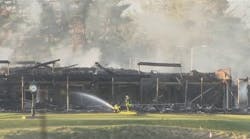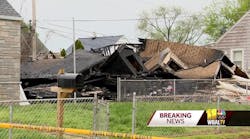Many times, the unthinkable does occur, placing firefighters in the forefront of the national news. When a fire or other emergency occurs in a faraway location, you may think that you will never have to deal with a similar situation. In the West, for example, wildland fires continue their rampage, killing several firefighters this year. In other regions wildland fires were respected, but were not a major concern - until a drought affected much of the country this past summer. With a lack of rain, conditions and priorities can change very rapidly. I had to be proactive and purchase wildland hand tools and related equipment for my own department because of the severe threat to my limited wildlands during our recent drought.
We all watch TV weather coverage to see severe storms. It is surprising to see a tornado in downtown Salt Lake City, but as we all know the first agencies to respond are the fire, EMS and rescue services, which had to be ready to face the unthinkable. During the latest hurricane season, many of us were glued to the television watching the updates. One hurricane turned and went out to sea, another hurricane followed a course through the Gulf of Mexico and hit Texas, yet another hurricane hit North Carolina and stayed for a few weeks.
Hurricane Floyd brushed the South and hit North Carolina, Virginia, Maryland, New Jersey and New York. The largest evacuation in U.S. history was caused by the potential onslaught of this powerful and deadly storm, which was 600 miles wide and packed 155 mph winds. Reports from North Carolina estimate the flooding caused by over 36 inches of rain after two hurricanes was worse than a 500-year flood. At least 22 North Carolina fire departments suffered major damage to equipment and stations. Damage to property and possessions is still being tabulated. The damage estimates are going to be astronomical.
As you watch reports of storms hitting other portions of the country, you thank your lucky stars that it was not your response area or own neighborhood. This time, though, many of us took a direct hit from the storm. When I spoke with the firefighters in Bound Brook, NJ, who endured floodwaters 18 feet high in their downtown district, they asked me whether I had heard of their plight. I told them I did eventually, but that I was a little busy as my department responded to 77 calls during the first few hours of the storm. This was quite above the average of our normal two calls per day.
Many fire departments up and down the East Coast responded to a record number of incidents due to the storm and related problems. Many rescuers put themselves in harm's way to rescue people trapped in their houses, cars and businesses by rapidly rising floodwaters. Many acts of personal dedication and heroism may have gone unnoticed except to those people who had to be rescued. A tip of the helmet to America's Bravest. We train to do this type of work someplace different each and every day.
In the same vein, on page 48 we present the first part of a report about a complicated trench rescue involving the Los Angeles County and City fire departments. The eight-hour operation focused nationwide attention on the two departments and the highly skilled rescuers. The Los Angeles County Fire Department celebrated its 75th anniversary last month, using the theme "Saving the Day for 75 Years." We couldn't have said it better ourselves.





